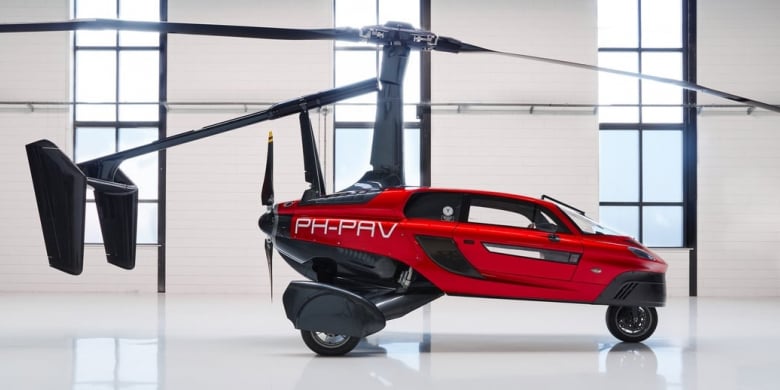What is Personal Air Vehicle (PAV)?
Personal Air Vehicle (PAV) is an under developing model of aircraft, designed and tested for on-demand aviation services, the way in which future transport would be. Incorporation of unmanned-aerial-vehicle (UAV) and electric propulsion systems plays the key and primary role of enabling PAV. Also, the onset of Vertical Takeoff and Landing (VTOL) nourished the feasibility of PAVs at the desired place.
The alternative approach to the traditional road transport was first flashed to the world by NASA at the ‘Aeronautics Vehicle Systems Program’ when it established a project of PAV in 2003. NASA shifted to a prize-based investment for the development efforts of the flying car, with NASA Centennial Challenge Prize funds being provided for competitions prioritized on PAV enhancing and implementing solutions. The flying car is not an astounding feature to note, but the integrating the fields of ‘drone technology’ and ‘robotic car’ into a singular. As worlds get smarter, every household would have a flying car in future, within just 10 to 20 years. PAV is scrutinized and explored to be autonomous is what the interesting fact to jot down. Achieving high degree of autonomy reckons the inclusion of artificial intelligence.
Need of PAV
Increase in traditional road congestions, sudden growth of vehicles on the road are the reliable reasons of moving to this alternative. Currently as of 2020, door-to-door average speed of the cars in US is 35mph and even worser in the peak areas like Los Angeles, where the speed strikes low of 22mph. U.S Department of Transportation says an estimated 6.7 Billion US galloons of gasoline is wasted by cars, idling in the traffic jam. Fast, safety and reliable transport are other rationales for PAV. PAV is said to ease the road traffics to more than 50% of that being experienced now. However, the ‘Highway in the sky’ seems an obstacle, as the PAVs would add traffic in the sky too, if numbers increase. Researches are looking forward to resolving all the appropriate hurdles.
Specifications & Features
The Personal Air Vehicles dominates the conventional transport by its noteworthy specifications or features. The vehicle is designed on electric power and so carries rechargeable electric batteries. Researches disclose atoning electric batteries with fuel cells would enhance the travel time and range, as the hydrogen in fuel cells exhibit considerable specific energy than modern electric batteries. PAV comes with a 5-seater and travels with a speed extent of 150-200 mph (240 – 320 km/hr). Compared to the traditional roadies, the flying car behaves more quiet, comfortable and reliable, as per the tests consented. PAVs are affordable and drives to almost 800 miles of range per full charge.
PAL-V is a leading designing and manufacturer of PAV, who has now started the booking of PAV, as your flying car.
Barriers
Aviation Safety
The Federal Aviation Administration (FAA) is not currently capable of sketching out the plans for safety ensured rules and regulations for aviation traffics. The administration sees difficulty of managing the increase of aircraft traffics that would be generated by PAVs. An interim plan suggests of having smaller airports, but the ultimate goal of the flying car is to be feasible to travel onboard from their own flats. This creates a partition of availing the car. PAVs are also ensured to not affect the airplanes and other aircrafts in any means.
Airspace Integration
It’s a barrier, accounting on the pathway of PAVs. As the aviation services encloses the entire airspace, confusion and accidents occurs often, if the pathway is not precisely defined. The integration of entire airspace creates a free mobility, which may be misled. The obstacle brings to the point of having, for an instance, fixed altitude of travel on basis of displacement.
Noise
Flying cars operating on fuel engines may create unpleasant heavy decibels of sound, messing up the ordinary lifestyle of homes and streets. Fuel operating flying cars may sound aggravate as helicopters do.
Operational costs & usability.
The chock-full obstruction of making real the flying cars are bringing down the model to the affordable economic level and a better user interface. Challenges are encountered often on this, as the starting price of the available aviation service approximates $55,000 (₹ 45 Lakhs). But the future is marching to utilizing it as public transport and the days are not so far to catch a flying public transport.
Future Transportation
Hyundai recently promised Uber to build a flying Uber service, named ‘Uber Air Taxi Service’, which is nothing but producing PAVs. The plan of the South-Korean automaker astonishes the world by means of its full-scale prototype asserted to display at Consumer Electronics Show in Las Vegas in January, this year. The five-person vehicle will have a cruising speed of 180 mph (290 km/h) and a cruising altitude of around 1,000–2,000 feet (300–600 meters) above ground. Hyundai says by using smaller, electric-powered rotors, the vehicle will produce less noise than a combustion engine helicopter, which is crucial for cities worried about noise pollution. During peak hours, it will require only about five to seven minutes for recharging. And Hyundai says it will have a range of 60 miles (100 kilometers) between charging.
We are going to have personal air vehicles that are both cars and planes, says Missy Cummings. She adds that technological hurdles wouldn’t seem like a real hurdle, but the psychological and cultural habits of the people in terms of giving up the car is the factual one. The advent of PAVs is viable by increasing the production of the same, and simultaneously reducing the manufacturing costs. All we need to do is manufacture robots to build robotic cars to make them cheaper. People should be excited about this: it promises much in terms of safer travel, and in parts of the world where the road and air networks are poor, people will be able to get the goods and services they need.
References:

